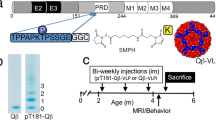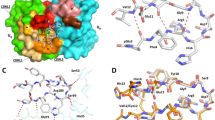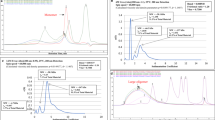Abstract
Much evidence indicates that abnormal processing and extracellular deposition of amyloid-β peptide (Aβ), a proteolytic derivative of the β-amyloid precursor protein (βAPP), is central to the pathogenesis of Alzheimer's disease (reviewed in ref. 1). In the PDAPP transgenic mouse model of Alzheimer's disease, immunization with Aβ causes a marked reduction in burden of the brain amyloid2,3. Evidence that Aβ immunization also reduces cognitive dysfunction in murine models of Alzheimer's disease would support the hypothesis that abnormal Aβ processing is essential to the pathogenesis of Alzheimer's disease, and would encourage the development of other strategies directed at the ‘amyloid cascade’. Here we show that Aβ immunization reduces both deposition of cerebral fibrillar Aβ and cognitive dysfunction in the TgCRND8 murine model of Alzheimer's disease without, however, altering total levels of Aβ in the brain. This implies that either a ∼50% reduction in dense-cored Aβ plaques is sufficient to affect cognition, or that vaccination may modulate the activity/abundance of a small subpopulation of especially toxic Aβ species.
This is a preview of subscription content, access via your institution
Access options
Subscribe to this journal
Receive 51 print issues and online access
$199.00 per year
only $3.90 per issue
Buy this article
- Purchase on Springer Link
- Instant access to full article PDF
Prices may be subject to local taxes which are calculated during checkout



Similar content being viewed by others
References
Steiner, H., Capell, A., Leimer, U. & Haass, C. Genes and mechanisms involved in beta-amyloid generation and Alzheimer's disease. Eur. Arch. Psychiat. Clin. Neurosci. 249, 266– 270 (1999).
Schenk, D. et al. Immunization with Aβ attenuates Alzheimer's disease-like pathology in the PDAPP mouse. Nature 400, 173–177 (1999).
Bard, F. et al. Peripherally administered antibodies against amyloid beta-peptide enter the central nervous system and reduce pathology in a mouse model of Alzheimer disease. Nature Med. 6, 916– 919 (2000).
Whitehouse, P. J. et al. Clinical trial designs for demonstrating disease-course-altering effects in dementia. Alzheimer Dis. Assoc. Disord. 12, 281–294 (1998).
Morris, R. Developments of a water-maze procedure for studying spatial learning in the rat. J. Neurosci. Methods 11, 47– 60 (1984).
Markowska, A. L., Long, J. M., Johnson, C. T. & Olton, D. S. Variable-interval probe test as a tool for repeated measurements of spatial memory in the water maze. Behav. Neurosci. 107, 627–632 (1993).
Martin, P. & Bateson, P. Measuring Behaviour (Cambridge Univ. Press, Cambridge, 1996).
Hsiao, K. Correlative memory deficits, Aβ elevation, and amyloid plaques in transgenic mice. Science 274, 99–102 (1996).
Rogers, S. L., Farlow, M. R., Doody, R. S., Mohs, R. & Friedhoff, L. T. A 24-week, double-blind, placebo-controlled trial of donepezil in patients with Alzheimer's disease. Donepezil study group. Neurology 50, 136–145 (1998).
Terry, R. D., Masliah, E. & Hansen, L. A. in Alzheimer Disease 2nd edn (eds Terry, R. D., Katzman, R., Bick, K. C. & Sisodia, S. S.) (Lippincott Williams Wilkins, Philadelphia, 1999).
Moechars, D. et al. Early phenotypic changes in transgenic mice that over-express different mutants of amyloid precursor protein. J. Biol. Chem. 274, 6483–6492 ( 1999).
Hsia, A. Y. Plaque-independent disruption of neural circuits in Alzheimer's disease mouse models. Proc. Natl Acad. Sci. USA 96, 3228 –3233 (1999).
Solomon, B., Koppel, R., Hanan, E. & Katzav, T. Monoclonal antibodies inhibit in vitro fibrillar aggregation of the Alzheimer β-amyloid peptide. Proc. Natl Acad. Sci. USA 93, 452– 455 (1996).
Lorenzo, A. & Yanker, B. A. β-amyloid neurotoxicity requires fibril formation and is inhibited by Congo red. Proc. Natl Acad. Sci. USA 91, 12243–12247 (1994).
Walsh, D. M. et al. Amyloid β-protein fibrillogenesis. Structure and biological activity of protofibrillar intermediates. J. Biol. Chem. 274, 25945–25952 (1999).
Hartley, D. M. Protofibrillar intermediates of amyloid β-protein induce acute electrophysiological changes and progressive neurotoxicity in cortical neurons. J. Neurosci. 19, 8876–8884 ( 1999).
McLean, C. A. et al. Soluble pool of Aβ amyloid as a determinant of severity of neurodegeneration in Alzheimer's disease. Ann. Neurol. 46, 860–866 (1999).
Naslund, J. et al. Correlation between elevated levels of amyloid β-peptide in the brain and cognitive decline. J. Am. Med. Assoc. 283, 1571–1577 (2000).
Mucke, L. et al. High-level neuronal expression of Aβ1–42 in wild-type human amyloid protein precursor transgenic mice: synaptotoxicity without plaque formation. J. Neurosci. 20, 4050– 4058 (2000).
St George-Hyslop, P. & Westaway, D. Alzheimer's disease: antibody clears senile plaques. Nature 400, 116–117 (1999).
Lu, D. C. A second cytotoxic proteolytic peptide derived from amyloid β-protein precursor. Nature Med. 6, 397– 404 (2000).
McLaurin, J., Franklin, T., Chakrabartty, A. & Fraser, P. E. Phosphatidylinositol and inositol involvement in Alzheimer amyloid-beta fibril growth and arrest. J. Mol. Biol. 278, 183 –194 (1998).
Janus, C. Spatial learning in transgenic mice expressing human presenilin 1 (PS1) transgenes. Neurobiology of Aging 21, 541– 549 (2000).
Cain, D. P., Beiko, J. & Boon, F. Navigation in the water maze: the role of proximal and visual cues, path intergration, and magnetic field information. Psychobiology 25, 286–293 (1997).
Dudchenko, P. A., Goodridge, J. P., Seiterle, D. A. & Taube, J. S. Effects of repeated disorientation on the acquisition of spatial tasks in rats: dissociation between the appetetive radial arm maze and aversive water maze. J. Exp. Psychol. 23, 194– 210 (1997).
Gass, P. et al. Deficits in memory tasks of mice with CREB mutations depend on gene dosage. Learn Mem. 5, 274– 288 (1998).
Wehner, J. M., Sleight, S. & Upchurch, M. Hippocampal protein kinase C activity is reduced in poor spatial learners. Brain Res. 523, 181 –187 (1990).
Wisniewski, H. M., Wen, G. Y. & Kim, K. S. Comparison of four staining methods on the detection of neuritic plaques. Acta Neuropathol. 78, 22–27 (1989).
Susuki, N. et al. An increased percentage of long amyloid B protein secreted by Familial Amyloid β Protein Precursor (BAPP717) mutants. Science 264, 1336–1340 ( 1994).
Citron, M. et al. Mutant presenilins of Alzheimer's Disease increase production of 42 residue amyloid β-protein in both transfected cells and transgenic mice. Nature Med. 3, 67– 72 (1997).
Acknowledgements
This work was supported by the Medical Research Council of Canada, Howard Hughes Medical Research Foundation, Alzheimer Society of Ontario, The W. Garfield Weston Foundation and the US National Institute of Aging. We thank G. Carlson for useful discussions, and R. Renlund, K. Parisien, J. Haight and J. Cowieson for help during mice immunization. None of the authors has a financial or other relationship with Elan Pharmaceuticals Inc.
Author information
Authors and Affiliations
Supplementary information
Rights and permissions
About this article
Cite this article
Janus, C., Pearson, J., McLaurin, J. et al. Aβ peptide immunization reduces behavioural impairment and plaques in a model of Alzheimer's disease. Nature 408, 979–982 (2000). https://doi.org/10.1038/35050110
Received:
Accepted:
Issue Date:
DOI: https://doi.org/10.1038/35050110
This article is cited by
-
Updates on mouse models of Alzheimer’s disease
Molecular Neurodegeneration (2024)
-
Amyloid-β specific regulatory T cells attenuate Alzheimer’s disease pathobiology in APP/PS1 mice
Molecular Neurodegeneration (2023)
-
Deletion of Abi3/Gngt2 influences age-progressive amyloid β and tau pathologies in distinctive ways
Alzheimer's Research & Therapy (2022)
-
Sodium–calcium exchanger isoform-3 targeted Withania somnifera (L.) Dunal therapeutic intervention ameliorates cognition in the 5xFAD mouse model of Alzheimer’s disease
Scientific Reports (2022)
-
Faulty autolysosome acidification in Alzheimer’s disease mouse models induces autophagic build-up of Aβ in neurons, yielding senile plaques
Nature Neuroscience (2022)
Comments
By submitting a comment you agree to abide by our Terms and Community Guidelines. If you find something abusive or that does not comply with our terms or guidelines please flag it as inappropriate.



